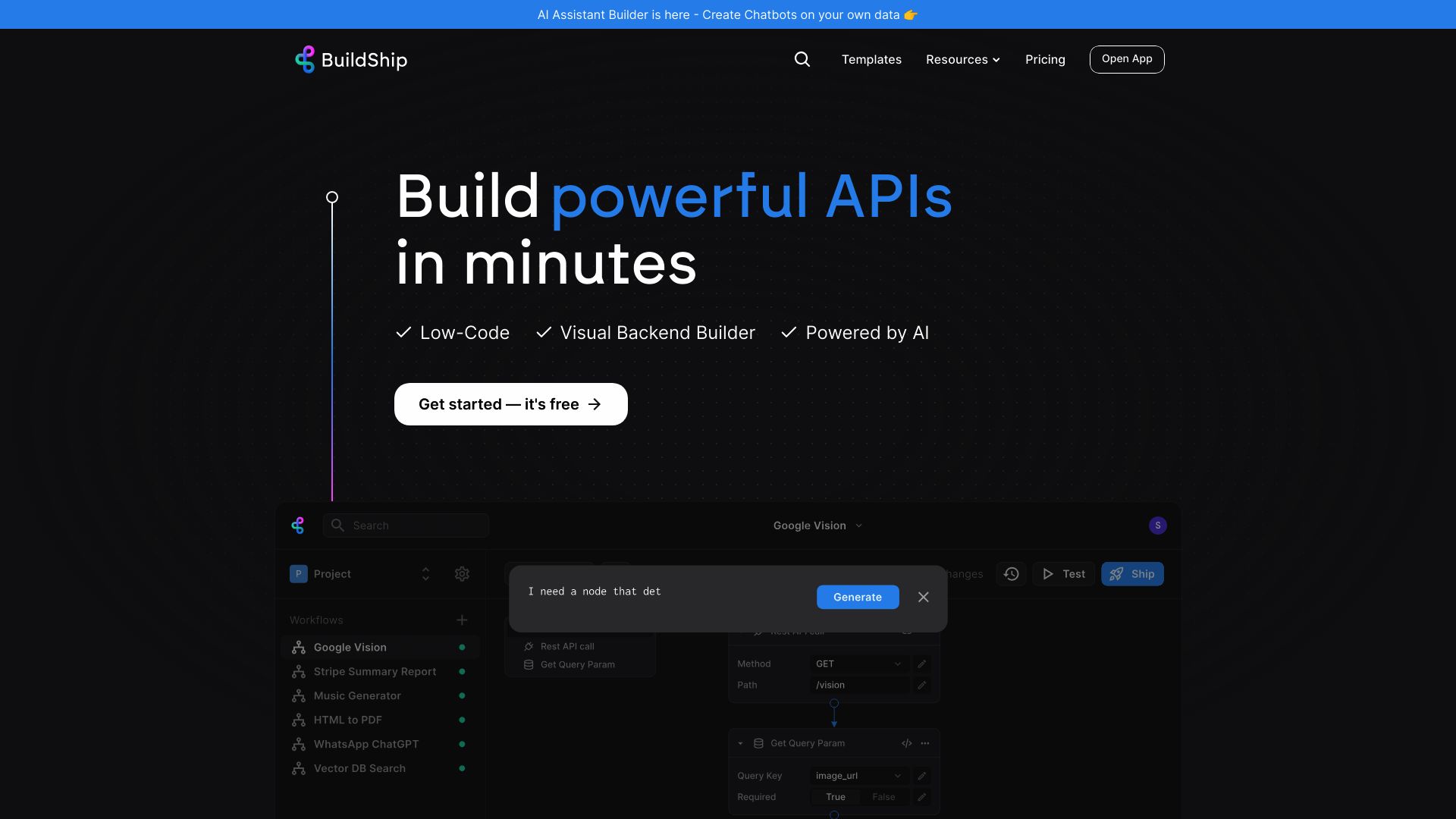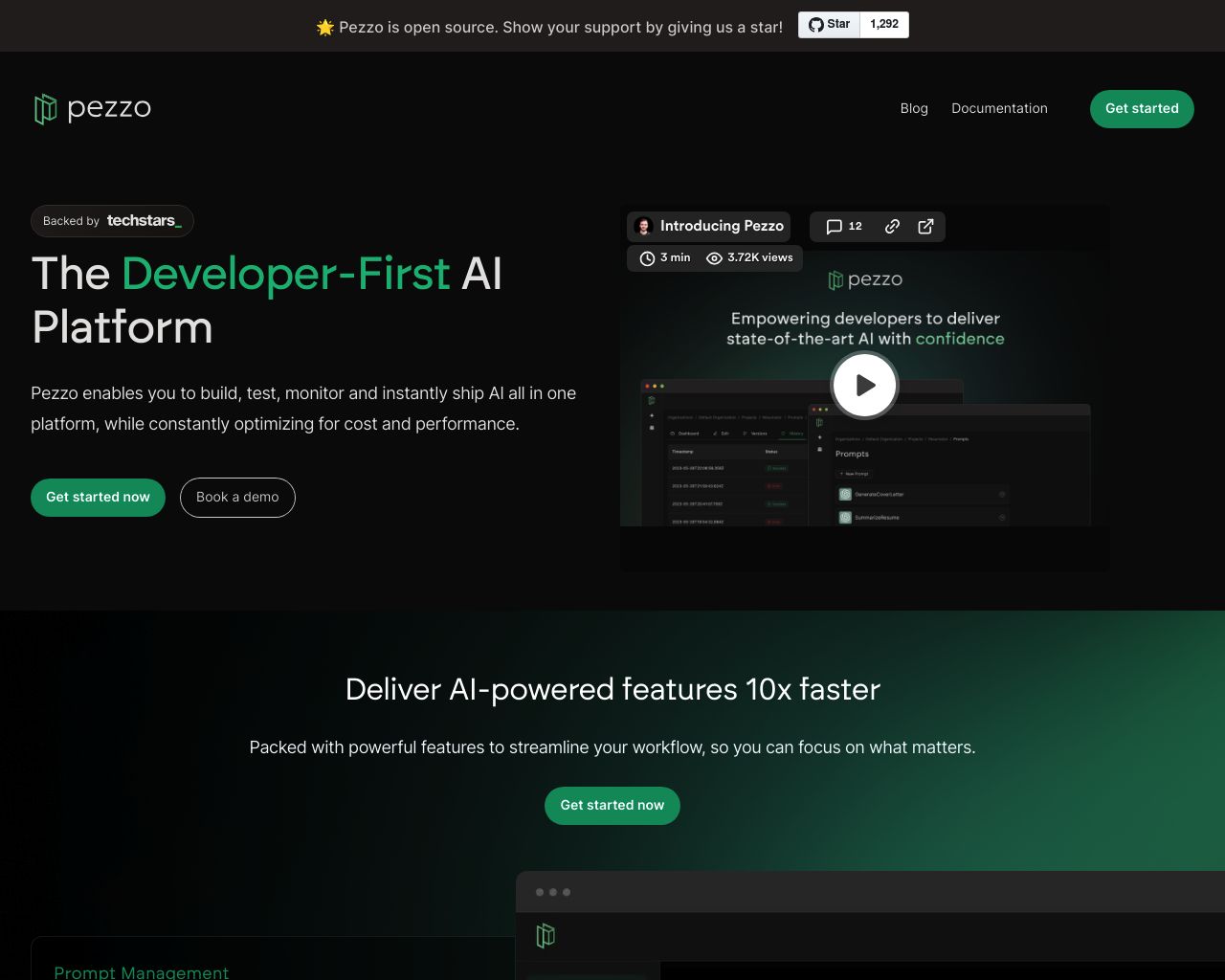BuildShip vs. Pezzo: Comparing AI Development Platforms
AI development platforms revolutionize how businesses create, deploy, and manage intelligent solutions. BuildShip’s visual workflow builder and Pezzo’s open-source toolkit offer unique approaches to streamline AI integration. This comparison explores their key features, deployment capabilities, and potential limitations. We’ll examine how these platforms tackle common challenges in AI development and identify areas where they excel or fall short.
By analyzing BuildShip’s no-code interface alongside Pezzo’s prompt management tools, we’ll uncover which solution best fits various development needs and use cases. This guide aims to equip you with the insights needed to choose the most suitable AI platform for your projects.
BuildShip Overview
BuildShip empowers developers and businesses to create scalable backend workflows and APIs without extensive coding. The platform’s visual no-code interface simplifies the process of building complex automations, integrating AI models, and deploying production-ready solutions.
BuildShip’s core offering centers on its drag-and-drop workflow builder. Users can construct sophisticated backend processes by combining pre-built nodes or generating custom ones using AI. The platform seamlessly integrates various data sources, APIs, and AI models, enabling the creation of versatile workflows. For those requiring more control, BuildShip allows custom logic implementation in JavaScript or TypeScript.
BuildShip empowers developers and businesses to create scalable backend workflows and APIs without extensive coding.


The platform excels in its deployment capabilities. Users can transform their workflows into production-grade APIs, integrate them into applications, or schedule them for automatic execution. BuildShip leverages Google Cloud Platform for hosting, ensuring scalability and reliability. The platform also prioritizes security, using Google Cloud Secret Manager to safeguard API keys and sensitive information.
Users can transform their workflows into production-grade APIs, integrate them into applications, or schedule them for automatic execution.
While BuildShip offers powerful features, it may have limitations in certain areas. The platform doesn’t explicitly mention features for maintaining memory and context across different workflows or sessions. Additionally, there’s no clear indication of audit logs for detailed analytics or specific IP control features. These potential gaps might impact users requiring extensive monitoring or fine-grained access control.
BuildShip positions itself as a versatile solution for rapid backend development. Its combination of visual tools, AI integration, and cloud deployment aims to accelerate workflow creation tenfold. The platform caters to a broad audience, from developers seeking efficient ways to build complex systems to businesses looking to automate processes without deep technical expertise.
Pezzo Overview
Pezzo empowers developers to streamline AI development through its open-source toolkit. The platform tackles key challenges in AI workflow management, offering solutions for prompt design, versioning, and collaboration.


Pezzo’s standout features include effortless prompt and version management, enabling developers to handle AI prompts efficiently. This accelerates the delivery of AI solutions by keeping teams aligned on the latest versions. The platform also incorporates A/B testing and experimentation tools, allowing users to optimize their AI models for better conversion rates.
Pezzo’s standout features include effortless prompt and version management, enabling developers to handle AI prompts efficiently.
Cost optimization emerges as another significant benefit, with Pezzo providing tools to maximize efficiency in AI operations. Users can potentially save up to 50% on costs, making it an attractive option for businesses looking to balance innovation with budget constraints. Additionally, Pezzo offers comprehensive troubleshooting capabilities, including execution history, time-travel debugging, and test suites, enhancing developer confidence in AI model deployment.
Users can potentially save up to 50% on costs, making it an attractive option for businesses looking to balance innovation with budget constraints.
While Pezzo excels in many areas, it lacks some advanced features found in other platforms. The absence of a hosted vector database and specialized crawlers for sitemaps, YouTube transcripts, or URLs may limit its utility for certain data-intensive applications. Additionally, Pezzo does not offer specific support for PDF, Word, or TXT file processing, which could be a drawback for users working with diverse document types.
Feature Comparison
BuildShip and Pezzo offer distinct approaches to AI development, each with its own strengths and limitations. BuildShip provides a comprehensive visual workflow builder for creating backend processes and APIs without extensive coding. Its drag-and-drop interface allows users to construct complex workflows by combining pre-built nodes or generating custom ones using AI. In contrast, Pezzo focuses on streamlining AI development through prompt management, versioning, and collaboration tools.
BuildShip excels in its deployment capabilities, allowing users to transform workflows into production-grade APIs and integrate them seamlessly into applications. It leverages Google Cloud Platform for hosting, ensuring scalability and reliability. Pezzo, on the other hand, emphasizes cost optimization and troubleshooting, offering tools to maximize efficiency in AI operations and comprehensive debugging features.
However, both platforms have notable gaps. BuildShip lacks explicit features for maintaining memory and context across workflows, as well as detailed analytics and IP control. Pezzo, while strong in prompt management and experimentation, does not offer a hosted vector database or specialized crawlers for data-intensive applications. Additionally, neither platform provides specific support for processing diverse document types like PDFs, Word files, or TXT files, which could limit their utility for certain use cases.
Feature Comparison Table
| BuildShip | Pezzo | SmythOS | |
|---|---|---|---|
| CORE FEATURES | |||
| Hosted Agents (Dev, Production) | ✅ | ❌ | ✅ |
| Visual Builder | ✅ | ❌ | ✅ |
| No-Code Options | ✅ | ❌ | ✅ |
| Memory & Context | ❌ | ❌ | ✅ |
| Autonomous Agents | ❌ | ❌ | ✅ |
| Explainability & Transparency | ❌ | ✅ | ✅ |
| Multimodal | ❌ | ✅ | ✅ |
| Problem-Solving Capabilities | ❌ | ✅ | ✅ |
| Multi-Agent Collaboration | ❌ | ✅ | ✅ |
| Human-AI Interaction | ❌ | ✅ | ✅ |
| Audit Logs for Analytics | ❌ | ✅ | ✅ |
| Work as Team | ❌ | ✅ | ✅ |
| SECURITY | |||
| Constrained Alignment | ❌ | ❌ | ✅ |
| IP Control | ✅ | ❌ | ✅ |
| COMPONENTS | |||
| Foundation AIs | ❌ | ✅ | ✅ |
| Huggingface AIs | ❌ | ✅ | ✅ |
| Zapier APIs | ❌ | ✅ | ✅ |
| Classifiers | ❌ | ✅ | ✅ |
| Data Lakes | ❌ | ❌ | ✅ |
| DEPLOYMENT OPTIONS (EMBODIMENTS) | |||
| Staging Domains | ❌ | ✅ | ✅ |
| Production Domains | ❌ | ✅ | ✅ |
| Deploy as Site Chat | ❌ | ✅ | ✅ |
| Deploy as Scheduled Agent | ✅ | ❌ | ✅ |
| Deploy as GPT | ❌ | ✅ | ✅ |
| DATA LAKE SUPPORT | |||
| Hosted Vector Database | ❌ | ❌ | ✅ |
| Sitemap Crawler | ❌ | ❌ | ✅ |
| YouTube Transcript Crawler | ❌ | ❌ | ✅ |
| URL Crawler | ❌ | ✅ | ✅ |
| PDF Support | ❌ | ✅ | ✅ |
| Word File Support | ❌ | ✅ | ✅ |
| TXT File Support | ❌ | ✅ | ✅ |
Best Alternative to BuildShip and Pezzo
SmythOS stands out as the superior alternative to BuildShip and Pezzo for AI agent development and deployment. Our platform offers a comprehensive solution that combines powerful capabilities with unmatched ease of use. Unlike BuildShip’s limited workflow focus or Pezzo’s narrow emphasis on prompt management, SmythOS delivers a complete ecosystem for creating sophisticated AI agents.
SmythOS delivers a complete ecosystem for creating sophisticated AI agents.
We provide an intuitive drag-and-drop interface that allows users to rapidly design complex AI workflows without coding. This visual approach, combined with our extensive library of pre-built components and integrations, enables 99% faster development compared to other platforms. SmythOS supports a vast array of use cases — from chatbots and API services to scheduled tasks and multi-agent systems.
SmythOS supports a vast array of use cases — from chatbots and API services to scheduled tasks and multi-agent systems.
Our platform excels in critical areas where BuildShip and Pezzo fall short. SmythOS offers robust memory and context management, allowing agents to maintain state across interactions. We enable true autonomous operation, empowering agents to independently solve problems and collaborate. Our multi-modal capabilities support text, voice, and visual inputs, expanding the scope of possible applications.
SmythOS offers robust memory and context management… We enable true autonomous operation, empowering agents to independently solve problems and collaborate.
SmythOS also prioritizes enterprise needs that other platforms neglect. We provide granular security controls, audit logging, and seamless scalability to support mission-critical deployments. With features like our hosted vector database and support for diverse data sources, SmythOS is built to handle real-world, data-intensive scenarios that leave other platforms struggling.
By choosing SmythOS, users gain access to a future-proof platform designed to unlock the full potential of AI agents across any industry or use case. Our commitment to continuous innovation ensures SmythOS will remain the premier choice for businesses seeking to harness the power of artificial intelligence.
Conclusion
BuildShip and Pezzo offer unique approaches to AI development, each with distinct strengths. BuildShip’s visual workflow builder simplifies backend process creation, while Pezzo focuses on streamlining AI development through prompt management and collaboration tools. However, SmythOS emerges as the superior choice, combining the best of both worlds and offering additional capabilities.
SmythOS’s drag-and-drop interface rivals BuildShip’s ease of use while providing more extensive AI model support and integration options. Unlike Pezzo’s limited scope, SmythOS offers a comprehensive suite of tools for creating, deploying, and managing AI agents across various platforms. Our platform’s ability to maintain memory and context across workflows, coupled with its multi-agent collaboration features, sets it apart from both competitors.
Where BuildShip and Pezzo fall short in document processing and data management, SmythOS excels. We support PDF, Word, and TXT file processing, and offer a hosted vector database for efficient data handling. Our platform also provides robust debugging tools, audit logs, and analytics, addressing the limitations found in both BuildShip and Pezzo.
Ready to experience the future of AI development? Create a free SmythOS account today and discover how our platform can revolutionize your workflow. With unlimited agents, a 30-day money-back guarantee, and the power to automate anything, SmythOS is your gateway to unlocking the full potential of AI for your business.
Last updated:
Disclaimer: The information presented in this article is for general informational purposes only and is provided as is. While we strive to keep the content up-to-date and accurate, we make no representations or warranties of any kind, express or implied, about the completeness, accuracy, reliability, suitability, or availability of the information contained in this article.
Any reliance you place on such information is strictly at your own risk. We reserve the right to make additions, deletions, or modifications to the contents of this article at any time without prior notice.
In no event will we be liable for any loss or damage including without limitation, indirect or consequential loss or damage, or any loss or damage whatsoever arising from loss of data, profits, or any other loss not specified herein arising out of, or in connection with, the use of this article.
Despite our best efforts, this article may contain oversights, errors, or omissions. If you notice any inaccuracies or have concerns about the content, please report them through our content feedback form. Your input helps us maintain the quality and reliability of our information.
